Dental instruments are essential tools for diagnosing and treating dental conditions. This guide provides a comprehensive overview, including detailed pictures and names of instruments, ensuring proper identification and use.
Overview of Dental Instruments
Dental instruments are specialized tools designed for various dental procedures, ranging from diagnostics to complex surgeries. They include mirrors, explorers, scalers, probes, excavators, chisels, and forceps, each serving specific functions. Proper setup and organization are crucial for efficiency, with instruments arranged by procedure. Resources like PDF guides provide visual aids, helping professionals identify and use instruments effectively. These tools are vital for ensuring accurate diagnoses, effective treatments, and maintaining patient care standards. Understanding their roles and proper handling is essential for dental professionals to deliver high-quality care.
Importance of Knowing Dental Instruments
Understanding dental instruments is crucial for effective patient care. Accurate identification and use of tools like mirrors, scalers, and probes ensure precise diagnoses and treatments. A PDF guide offers detailed pictures and names, aiding professionals in recognizing instruments quickly. This knowledge enhances efficiency and safety, preventing errors during procedures. Proper instrument handling also supports infection control and sterilization processes. For dental assistants and dentists, familiarity with these tools is essential for delivering high-quality care. Regular training and reference materials, such as PDF guides, help maintain proficiency and adapt to advances in dental technology.
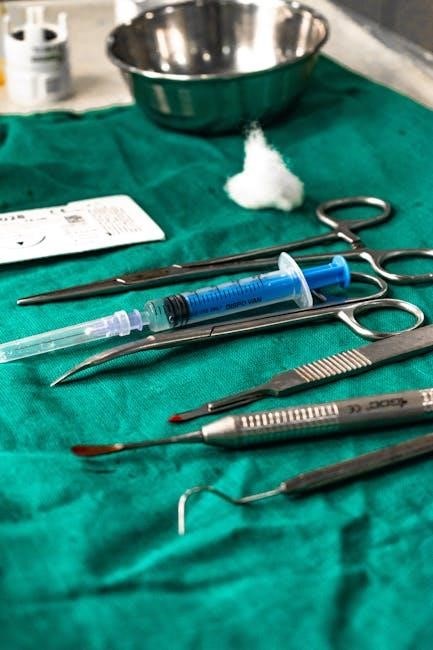
Classification of Dental Instruments
Dental instruments are categorized into diagnostic, preventive, restorative, and surgical tools. Each group serves specific functions, with examples including mirrors, scalers, and forceps, aiding precise dental procedures.
Diagnostic Instruments
Diagnostic instruments are crucial for assessing dental conditions. Common tools include mirrors, used for visualizing hard-to-reach areas, and explorers, which detect cavities and irregularities. Probes measure pocket depths, aiding in periodontal evaluations. These instruments are essential for accurate diagnoses, ensuring effective treatment planning. Proper use and identification of these tools are highlighted in detailed guides, often accompanied by pictures and names for easy reference. By combining visual and functional knowledge, dental professionals can efficiently diagnose and address patient needs, making diagnostic instruments indispensable in daily practice. Their role in preventive care underscores their importance in maintaining oral health.
Preventive Instruments
Preventive instruments are designed to maintain oral health and prevent dental issues. Key tools include scalers, used to remove plaque and tartar, and polishing instruments, which smooth tooth surfaces. Fluoride applicators deliver treatments to strengthen enamel, while ultrasonic cleaners effectively remove stubborn deposits. These instruments are vital for routine cleanings and preventive care. Detailed guides, often featuring pictures and names, help dental professionals identify and use these tools correctly. Proper use of preventive instruments ensures patients receive thorough care, reducing the risk of future dental problems. They play a critical role in promoting long-term oral health and are essential in every dental practice.
Restorative Instruments
Restorative instruments are used to repair and reconstruct teeth damaged by decay or trauma. Common tools include excavators, which remove decayed tissue, and chisels, used to shape dentin. Handpieces, such as drills, prepare teeth for fillings, while burnishers smooth rough surfaces. Amalgam condensers pack filling material into cavities, and curing lights harden resin-based restoratives. These instruments are essential for procedures like fillings, crowns, and inlays. Detailed guides, often featuring pictures and names, help professionals master their use. Proper selection and technique ensure durable, natural-looking restorations. Restorative instruments play a vital role in preserving tooth function and aesthetics, making them indispensable in modern dentistry.
Surgical Instruments
Surgical instruments are specialized tools used in invasive dental procedures, such as extractions, implants, and tissue surgeries. Common examples include scalpels for incisions, forceps for extracting teeth, and elevators to loosen teeth or remove fragments. Surgical handpieces are used for precise bone cutting or shaping, while periosteal elevators help lift and retract tissue. These instruments are designed for accuracy and efficiency in complex procedures. Detailed guides, often featuring pictures and names, assist professionals in identifying and using these tools correctly. Proper handling of surgical instruments ensures safe and effective outcomes, making them indispensable in advanced dental surgeries. Their role is critical in procedures requiring precision and care, such as implant placement or wisdom tooth removal.
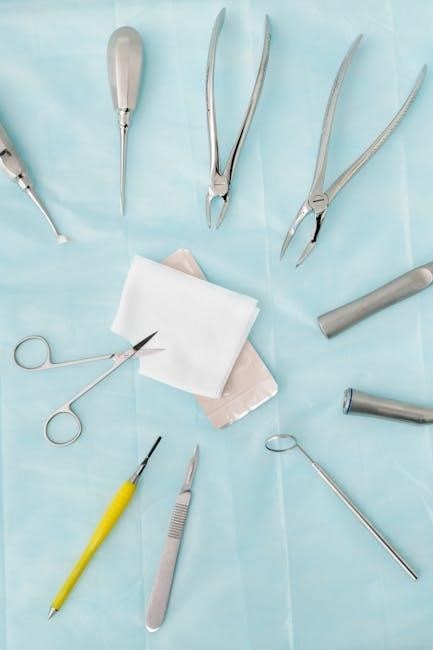
Common Dental Instruments and Their Uses
Common dental instruments include mirrors, explorers, and scalers, used for examining, probing, and removing plaque. Detailed pictures and names in guides help identify tools for various procedures, ensuring proper use and effectiveness.
Mirrors and Explorers
Dental mirrors and explorers are fundamental instruments used for examining and diagnosing oral conditions; Mirrors provide clear visibility of difficult-to-reach areas, aiding in accurate assessments. Explorers, with their sharp tips, detect early signs of decay and irregularities on tooth surfaces. Both tools are essential for preventive care, enabling dentists to identify issues before they escalate. The dental instruments pictures and names pdf guide offers detailed visuals and descriptions, helping professionals and students recognize and understand these instruments. Proper use of mirrors and explorers ensures effective patient care and precise diagnoses. Their inclusion in procedural setups highlights their importance in daily dental practice, making them indispensable in every dental clinic.
Scalers and Probes
Scalers and probes are essential dental instruments used for assessing and treating periodontal conditions. Scalers remove plaque, tartar, and stains from teeth, both above and below the gum line, ensuring proper oral hygiene. Probes measure pocket depths to diagnose and monitor periodontal disease progression. These tools are crucial for preventive and restorative procedures, aiding in maintaining patient oral health. The dental instruments pictures and names pdf guide provides clear images and descriptions of scalers and probes, helping professionals identify and use them effectively. Understanding their functions is vital for accurate diagnoses and effective treatments. Regular use of these instruments in clinical settings highlights their importance in maintaining patient care and preventing complications;
Excavators and Chisels
Excavators and chisels are specialized dental instruments used primarily in restorative procedures. Excavators remove decayed tooth material, preparing the cavity for fillings, while chisels shape or remove enamel and dentin. These tools are essential for precise cavity preparation and ensuring proper adaptation of restorative materials; The dental instruments pictures and names pdf guide illustrates various types of excavators and chisels, highlighting their unique features and applications. Understanding their design, such as angled or curved blades, helps in selecting the right tool for specific clinical needs. Proper use of excavators and chisels ensures effective removal of decay and optimal shaping of tooth structures, contributing to successful restorative outcomes. Their role in dentistry underscores their importance in maintaining oral health and function.
Forceps and Elevators
Forceps and elevators are essential dental instruments used in extraction and surgical procedures. Dental forceps are designed to grip and remove teeth securely, while elevators are used to loosen teeth within the socket. The dental instruments pictures and names pdf guide provides detailed visuals and descriptions of various forceps and elevators, such as straight or curved forceps for different tooth locations. Elevators often feature angled or flat ends to apply controlled force during extraction. Proper use of these tools ensures safe and efficient tooth removal. The guide helps in identifying and understanding the specific designs and applications of forceps and elevators, making it a valuable resource for dental professionals and students alike.
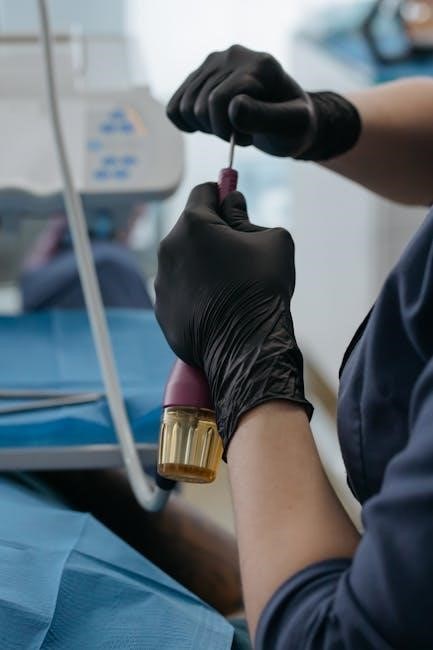
Dental Instrument Setup and Organization
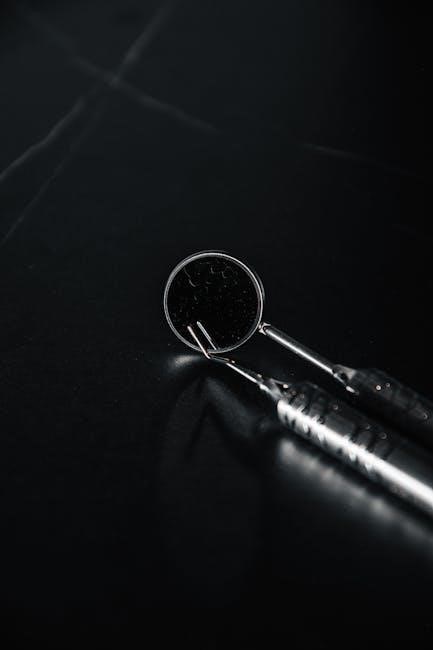
Proper setup and organization of dental instruments ensure efficiency and infection control. The dental instruments pictures and names pdf guide helps standardize organization for clear identification and quick access.
Setting Up Dental Trays
Setting up dental trays involves organizing instruments in a logical and accessible manner. The dental instruments pictures and names pdf guide provides visual references to help dental professionals arrange tools efficiently. By categorizing instruments based on their functions, such as diagnostic, preventive, or restorative, dental trays become more streamlined. This setup ensures that instruments are easily identifiable during procedures, reducing time spent searching for tools. The guide also highlights proper positioning and grouping, which aids in maintaining sterility and infection control. Proper tray setup enhances workflow efficiency, allowing dental teams to focus on patient care. Using the PDF guide ensures consistency and adherence to standard practices, making it an invaluable resource for both novice and experienced professionals.
Arranging Instruments by Procedure
Arranging dental instruments by procedure ensures efficiency and organization during treatments. The dental instruments pictures and names pdf guide helps identify tools specific to each procedure, such as exams, cleanings, or surgeries. By categorizing instruments based on their use, dental teams can quickly access what they need, saving time. This method also reduces the risk of contamination by grouping sterile and non-sterile instruments appropriately. The guide provides clear visuals and names, making it easier to recognize and place instruments correctly. Proper arrangement enhances workflow, reduces stress for the team, and improves patient care. It also ensures compliance with infection control standards, making it a critical step in dental practice management.
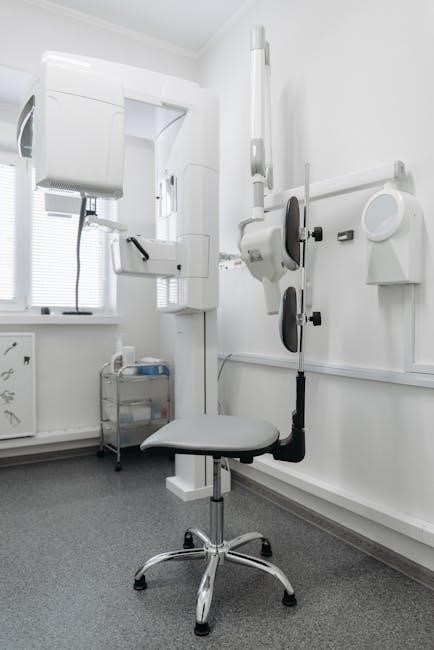
Maintenance and Sterilization of Dental Instruments
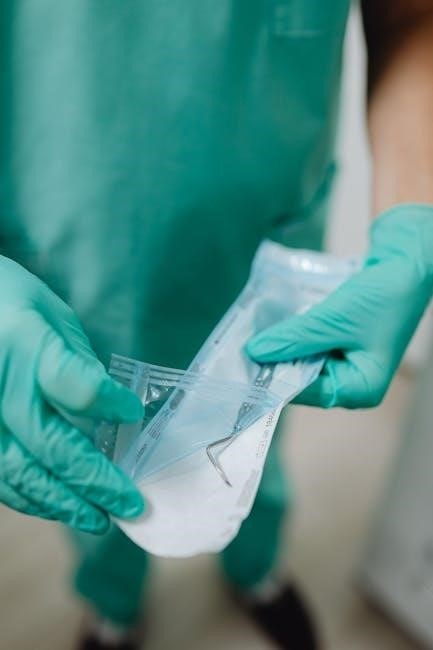
Proper cleaning, disinfection, and sterilization of dental instruments are crucial for patient safety and instrument longevity. The dental instruments pictures and names pdf guide helps identify tools requiring specific care.
Cleaning and Disinfection
Cleaning and disinfection are the first steps in maintaining dental instruments. These processes remove debris, bacteria, and viruses, ensuring instruments are safe for reuse. The dental instruments pictures and names pdf guide helps identify tools requiring specific cleaning methods. Ultrasonic cleaners are often used for intricate instruments, while disposable items are discarded. Disinfection involves soaking instruments in approved solutions to kill pathogens. Proper techniques prevent cross-contamination and maintain instrument functionality. The guide provides visuals to aid in recognizing instruments needing special care, ensuring compliance with infection control standards. Regular cleaning and disinfection are essential for patient safety and extending instrument lifespan. Always follow manufacturer guidelines for optimal results.
Sterilization Methods
Sterilization is a critical process for dental instruments to eliminate all forms of microbial life; Common methods include autoclaving, dry heat sterilization, and chemical vapor sterilization. Autoclaving, the most widely used method, employs high-pressure steam to destroy pathogens. Dry heat sterilization is less effective but suitable for instruments damaged by moisture. Chemical vapor sterilization is ideal for heat-sensitive tools. The dental instruments pictures and names pdf guide illustrates instruments requiring specific sterilization techniques. Proper sterilization prevents cross-contamination and ensures patient safety. Regular sterilization also extends the lifespan of dental instruments. Always adhere to manufacturer guidelines and infection control protocols for effective sterilization.
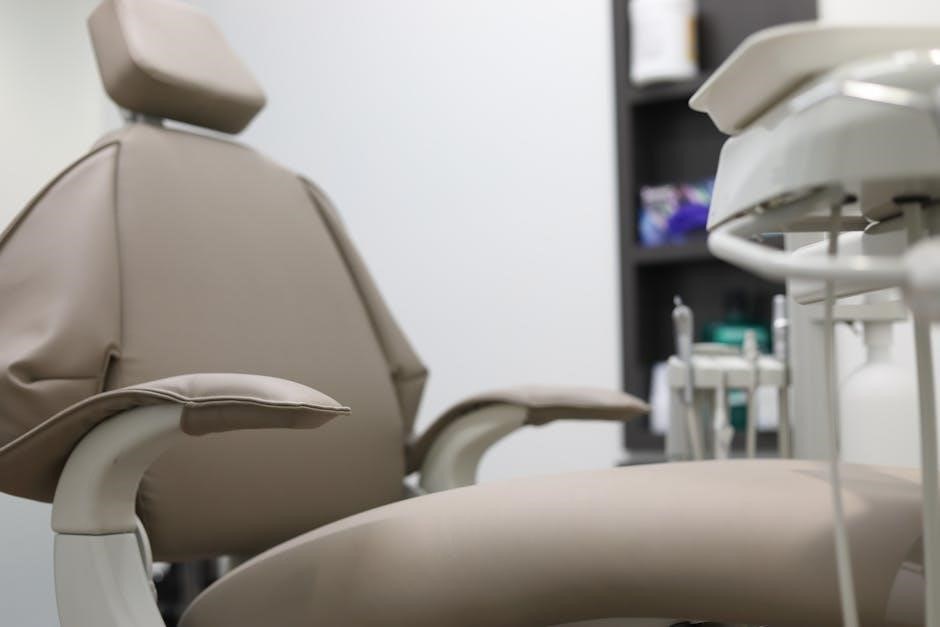
Dental Instrument Pictures and Names
The dental instruments pictures and names pdf guide provides high-quality images and clear labels for easy identification. It covers diagnostic, preventive, restorative, and surgical tools.
Visual Guide to Common Instruments
A visual guide to dental instruments enhances understanding by pairing high-quality images with names, enabling quick identification. This section showcases instruments like mirrors, scalers, and forceps, organized by category for clarity. Each image is labeled with the instrument’s name, its purpose, and key features, making it easier to distinguish between similar tools. The guide is particularly useful for students and professionals needing to familiarize themselves with dental instrumentation. By visually associating each instrument with its function, the guide simplifies learning and reference. It also includes examples of setups for various procedures, demonstrating how instruments are arranged in clinical settings. This resource is invaluable for both educational and practical applications, ensuring accurate identification and proper use of dental tools.
Identifying Instruments by Appearance
Identifying dental instruments by their appearance involves recognizing distinct features such as shape, size, and design. For example, mirrors have a round or rectangular glass surface attached to a handle, while explorers are thin, pointed tools. Scalers have triangular or curved blades, and forceps are recognizable by their hinged, grasping ends. By examining the handle shape, blade type, and unique markings, one can distinguish between instruments like excavators and chisels. This method is essential for quickly identifying tools in a clinical setting. Visual guides and comparisons further aid in mastering this skill, ensuring accurate recognition and proper use of dental instruments based on their physical characteristics.
Understanding dental instruments is crucial for effective dental care. This guide provides a comprehensive overview, helping professionals and students identify tools by appearance and function efficiently.
Key Takeaways
Understanding dental instruments is essential for effective patient care and procedural success. Familiarizing oneself with their pictures and names enhances learning and clinical proficiency. Diagnostic tools like mirrors and explorers aid in assessments, while preventive instruments such as scalers ensure proper oral hygiene. Restorative and surgical tools are vital for complex treatments, requiring precise handling. Proper setup, organization, and sterilization of instruments are critical for safety and efficiency. Utilizing a PDF guide provides easy access to visual identification, simplifying education and reference. Regular updates and hands-on practice further refine skills, ensuring mastery of dental instrumentation for optimal patient outcomes. Staying informed and skilled in this area is indispensable for dental professionals.
Resources for Further Learning
For comprehensive understanding, several resources are available to deepen knowledge of dental instruments. A PDF guide containing high-quality images and names of instruments is an excellent starting point. Online platforms like dental education websites and forums offer detailed descriptions and usage tutorials. Textbooks on dental instrumentation provide in-depth insights, while video demonstrations on YouTube channels specialize in dental education. Additionally, mobile apps like Dental Instrument Guide offer interactive learning experiences. Professional organizations such as the American Dental Association (ADA) publish resource materials. Attending workshops or enrolling in continuing education courses can also enhance proficiency. Utilizing these resources ensures a well-rounded understanding of dental instruments, supporting both students and professionals in their learning journey.

PDF Guide to Dental Instruments
The PDF guide provides detailed images, names, and descriptions of dental instruments, serving as an essential resource for students and professionals to enhance their knowledge.
Downloading and Using the Guide
The dental instruments pictures and names PDF guide can be easily downloaded from trusted sources like dental education websites or professional forums. Ensure the source is reputable to avoid low-quality content. Once downloaded, the guide can be accessed on any device, making it a convenient study tool. Use the guide to match images of instruments with their names, enhancing your familiarity. Create flashcards or notes for better retention. The PDF format allows zooming in on high-resolution images, aiding detailed study. Organize the guide by categories like diagnostic or restorative tools for systematic learning. Regularly review the guide to reinforce knowledge and improve identification skills, especially for exams or practical training. This resource is invaluable for students and professionals alike, offering a visual and interactive learning experience.
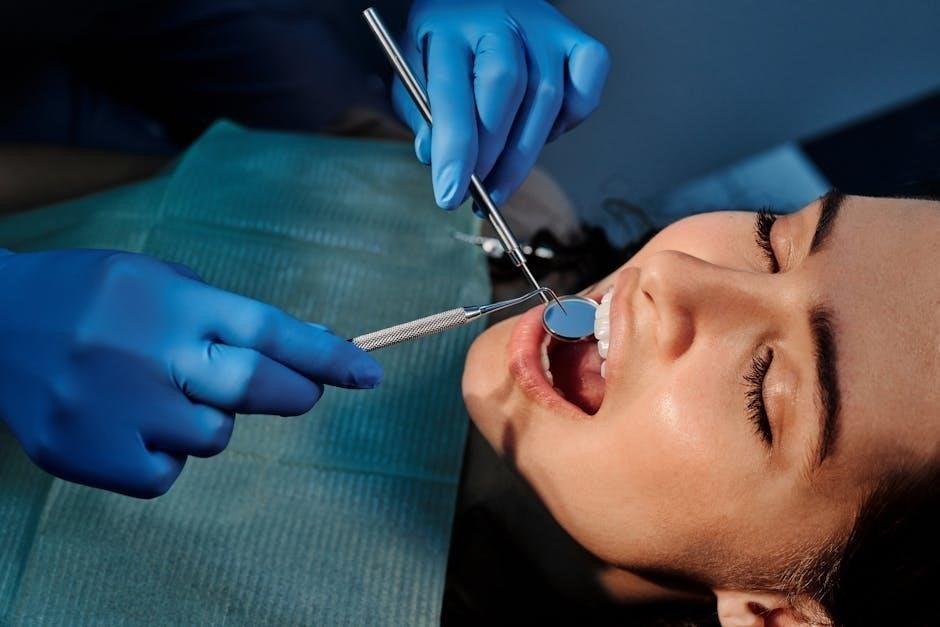
Benefits of the PDF Format
The PDF format offers numerous advantages for studying dental instruments. It provides high-resolution images and clear text, ensuring optimal visual clarity. PDFs are easily accessible on all devices, making them portable and convenient for learning on the go. The format retains its layout and design across platforms, ensuring consistency. PDF guides can be annotated, allowing users to add notes or highlights for better understanding. They are also searchable, enabling quick access to specific instruments or terms. Additionally, PDFs are easily printable, making them ideal for creating physical study materials. The compact file size saves storage space while maintaining quality. These features make the dental instruments pictures and names PDF a versatile and practical tool for dental professionals and students alike, enhancing both learning and reference capabilities.
